Frequently Asked Questions About Electrolysis
Electrolysis feels different to different people. Most people, if they feel anything much at all, will describe it as feeling something like a mosquito bite, a slight pinch or a gradually building heat, depending on the modality being used.
It is impossible to destroy hair growth tissue without sensation because each hair follicle is surrounded by its own network of nerve endings.
The sensation, which may or may not be felt, is assurance that destructive activity is taking place. Some clients sleep through hours of treatments and others honestly find 15 minutes to be irritating. We utilize advanced Apilus technology ensuring our clients a gentler and more comfortable way to permanent hair removal.
The sensation you might experience depends on many reasons including what face or body area where treatment is being delivered, and what method is used. Some parts of the body are more sensitive than others. If you have ever waxed or plucked, you'll find Electrolysis to be surprisingly comfortable.
Many adjustments can be made which help to make the treatment more comfortable for clients who may find it irritating. Some clients choose to take an over the counter analgesic such as Tylenol, Aspirin, or Advil 30 - 45 minutes before treatment and report treatment is very comfortable.
We will work within your personal comfort level and do have topical anesthetics available if you are one of the few clients who request it and do not have any medical contraindication for it's use.


What body areas can you work on, and can you work on both men and women? What about teens?


How does Electrolysis work?
We can work anywhere! Unwanted hair can be safely removed from any body or face area. Common areas include the hairline, eyebrows, upper and lower lip, cheeks, sideburns, ears, chin, neck, shoulders, arms and underarms, fingers, toes, hands, breasts, abdomen, bikini line, legs, back, ears, chest on men and women and teens (with parental consent only).
What will it feel like?

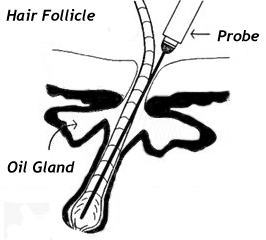
Electrology is the art and science of permanent hair removal utilizing a very small filament (called a probe) device. A tiny, sterile probe is inserted into the hair follicle and a small amount of electrical energy is discharged which destroys the hair growth tissue. There is no sensation with insertion. What clients feel is the delivery of the current. When this is competently and skillfully accomplished, the regenerative ability of the hair follicle is permanently eliminated. The hair is lifted out easily after treatment of the follicle.
Why should I choose Electrolysis over other hair removal methods?
If you want PERMANENT hair removal, Electrolysis is the ONLY way to achieve this goal. Electrolysis is the ONLY method of hair removal recognized as PERMANENT by the FDA and the AMA since 1875 - 150 years and counting!


Is it REALLY permanent? How long does it take?
Absolutely! However, Electrolysis is not an overnight sensation - we will not "sugar coat" that fact. Electrolysis requires a series of treatments to achieve permanency. The number of treatments necessary varies with each client and with the area being treated. Factors such as hair growth cycles, the quantity and structure of hair presented, previous use of temporary hair removal methods, heredity, hormone function, normal physiologic changes, certain medications, and stress all influence the treatment program for each individual.
In most cases it takes between 6 and 18 months depending on the area being treated to have absolute permanence.
It is very important to adhere to the recommended treatment schedule to achieve optimum results in the shortest time frame.
Without looking at your individual hair pattern and knowing what removal methods you have tried in the past, as well as the potential cause of the hair growth, it is impossible to accurately estimate how many treatments it will take if you ask for this information over the phone. If you would like to know what a treatment schedule for your individual situation looks like we encourage you to call for a free consultation and find out exactly what you will need to do to get great results from us.
What are the modalities you use in treatments?
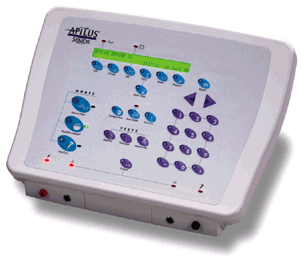

Electrolysis (also called Galvanic)--- Direct current (DC), is used to achieve chemical destruction of the hair follicle.
Thermolysis--- Alternating current (AC), sometimes referred to as high frequency or short-wave, is used to create heat which destroys the hair follicle.
The Blend (also referred to as Dual Modality)--- Both of the above currents are used simultaneously or sequentially to achieve dual action destruction of the hair follicle.


Why do I have to come in so often, and does it make a difference if I wait and let them all grow in and then come in?
You will get great results with any modality if you have a skilled Electrologist. Your Electrologist will select the best method for your individual situation.
Yes, it makes a difference! It is important to follow your individual treatment schedule to get the fastest results. Hairs are most effectively treated in their early growth stages when the hairs are finer and straighter and the target zone is smaller helping us to reach and destroy all of the germinative cells that line the hair follicle wall and grow hairs. Targeting smaller hairs also results in a more comfortable treatment for you. Regular treatments ensures catching hairs at this early growth stage and makes for a more effective treatment with less potential for regrowth. If you can make the time commitment at the beginning of treatment, you can think of it as taking time off the end so you get the best results in the shortest time frame.
Why should I choose Electrolysis over temporary hair removal methods like laser that also might only produce reduction in hair removal, and not permanent removal?
While laser promoters compare laser to Electrolysis, laser is actually not a permanent form of hair removal. Only a few laser devices have been cleared to claim reduction, not permanent elimination of hair by the FDA. Intense Pulsed Light (IPL) though often called laser, is NOT a true laser and not approved by the FDA to claim any efficacy. Electrolysis is cleared for permanent removal of hair. All laser assisted hair reduction is considered a temporary or long lasting method of hair removal, but not permanent. Additionally, laser hair reduction has not been evaluated for long-term safety of the patient's skin and health--new research is showing prolonged exposure to laser is capable of changing skin cells at the genetic level. Most people do not know that the acronym LASER stands for "Light Amplification by Stimulated Emission of Radiation". For more information on questions regarding the safety of laser hair reduction go to the FDA Laser Fact Page.
Essentially, laser targets the pigmented cells in hairs. It also takes a series of treatments (generally 6+ spaced out every 6 weeks or so) as all hair is not present at one time because of the growth cycle. On some body parts it takes up to a year to see a complete growth cycle--think about the hair on your head, if it all fell out and re-grew as fast as most people think, you'd have really, really short hair all the time! For laser treatments, clients shave prior to treatment, the laser is applied to the skin and heats the pigmented cells charring the moisture out of the hairs. The hairs slough/fall out on their own over the next few days or weeks. Skin looks sunburned after treatment and must be protected from the sun. The best results are very dark hair and very light skin. Darker skin tones or tanned skin must be treated with extreme caution as laser is attracted to pigment and may require bleaching and sun avoidance for 6 weeks prior to and following treatment if it can be treated at all. White, grey, and some red hairs are unaffected by laser. Laser does have potential to work with Electrolysis. One could argue laser would be well used to initially clear large areas like legs and then follow up with Electrolysis as the hair grows back in following a series of laser treatments.
Waxing, Sugaring, Depilatories, Tweezing, Threading vs. Electrolysis


Waxing, sugaring, chemical depilatories, and threading will remove all of the visible hair by ripping it out by the root. Except in the case of threading, the outer layer of skin is often removed when the hair is removed. It can result in skin problems including ingrown hair, scarring, pigment changes, and bruising. To keep your skin clear, (and contrary to advertising claims) all of these methods must be done frequently forever. You must also wait until hair is at least 1/4" to 1/2" long (about 3 weeks of growth) for the wax / sugaring "glue" to adhere to the removal strip.
Research has shown that any method that rips hair out by the root such as waxing, sugaring and plucking can actually increase hair growth in hormonally dependent areas such as the upper lip, chin, breasts, and abdomen as noted by the medical community! Not only will the hair in these follicles grow back coarser each time, but it may also be darker and longer and denser. This is not an issue on areas like eyebrows, underarms, arms, and legs because they are not hormonally dependent, so wax away in those areas if you must if your skin can tolerate it.
Tweezing vs. Electrolysis
Tweezing is easy to do, and inexpensive too. However hair can become coarser, darker and more prolific from the repeated tweezing and you may also encounter skin problems including scarring inside the follicle, ingrown hair, pigment changes, and scaring on the visible surface of the skin. Obviously it is not a permanent solution to unwanted hair. NEVER tweeze, wax or thread the upper or lower lip, chin, throat, breasts, or abdomen! You are stimulating growth in these areas because on a woman's body these areas are hormonally influenced by circulating testosterone as mentioned in the paragraph above. The hair will grow back thicker and darker. NEVER tweeze out ingrown hairs. You will make the situation worse. The hair will distort further and you will have a bigger lesion the next time it grows in, really, trust us. Stop performing self-surgery, we mean it.
Shaving or Trimming vs. Electrolysis
Shaving or trimming hair is inexpensive and easy. However, the hair does grow back quickly and feels coarse as it is cut off at the widest part of the hair where it comes out of the skin and also leaves a blunt tip. Shaving or trimming hair DOES NOT increase hair growth in any way. This is the biggest myth in hair removal. Hair is dead above the skin surface. Anything you do at this level does not affect hair growth. Shaving or trimming hair close to the surface of the skin is a safe, temporary method of removal for basically anywhere.
Depilatories vs. Electrolysis
Depilatories are essentially a chemical shave. It will remove the hair by dissolving it with a chemical. This can result in a chemical burning of the skin if you are not careful about patch testing first and respecting timing.
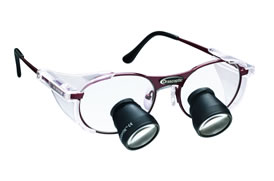

Is Electrolysis Safe?
Absolutely! Our office follows the American Electrology Association (AEA) Standards for Infection Control, standards set forth by the local health department and the CDC to ensure Electrolysis is performed under the highest standards of cleanliness and safety. We utilize only sterile disposable probes (one time use only!!) for all treatments and always utilize fresh latex-free medical grade disposable gloves for each treatment. Also, we use high powered loupes (like the ones your dentist may use) as shown in this photo to ensure a more accurate treatment.
What do you mean by hair that is "resting under the skin"?
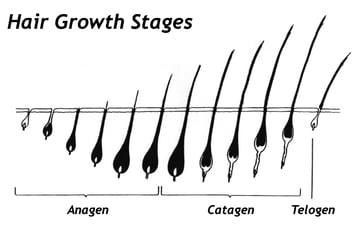

All hairs start growing in an empty hair follicle and then grow in to a fully mature hair. At the appropriate time in the life cycle of that hair it separates from its blood supply, ascends toward the surface of the skin and falls out. Following active growing periods, hair follicles go into a dormant or resting stage. The period of dormancy may last for an indefinite period of time, however, replacement hairs usually appear within 3 to 12 months varying depending on the body or face location. If you have ever brushed your hair and looked at the hairs in the brush you may have noticed the white tuft on the end of them. These are hairs that were naturally shed, as opposed to when you pluck, say an eyebrow hair, it might have a moist shinny ball at the end. This is a growing hair.
Not all hairs are visible on the surface of the skin at any one time. Depending on the area of the body, you may wait for 12 weeks or 12 months to see all of the dormant hairs come to the surface as your hair pattern fills in. The appearance of these replacement hairs from dormant hair follicles should not be mistaken as regrowth from previously treated follicles.
What will my skin look like? Will everyone know I've been in?


Immediately following treatment, there may be a slight redness and/or swelling which usually disappears within a few minutes to a few hours. Though not desirable on face work, sometimes tiny white pustules or small red dots may occur - we are all different individuals, but rest assured they will heal quickly and not leave any lasting marks. On body work pinpoint red dots almost always develop, and they too will heal with no lasting marks. It is important to remember that scabs are a part of the normal healing process in some people. If this does occur, the client is advised to not pick them off. Be sure and tell your Electrologist about any skin reactions so they can work with you to minimize their occurrence. When Electrolysis is administered by a qualified Electrologist using state-of-the-art technology and techniques, the results are exciting!
Can women begin or continue Electrolysis treatments during pregnancy?
Yes. Electrolysis has never been proven harmful in any way to pregnant women or to a fetus. Our office does not treat the breasts, abdomen, or bikini line of pregnant women in their last trimester due to the increased sensation they experience. We also require a note from your physician for approval.
Can hairs be removed from moles (hairy nevus)?
Yes, but we require a note from your physician stating it is a common hairy nevus (benign mole with hair growing out of it) and is safe to treat. Even with a note if the mole looks suspicious under the examination with our loupes it will not be treated in the rare event that it may be cancerous or pre-cancerous looking.
Can you work on my tattoo?
Yes. Electrolysis has never been a problem for tattoos. In fact it is one of the few hair removal methods that doesn't affect the design. Many people report that it makes their tattoo "pop" visually.
DON'T LET UNWANTED HAIR RUIN THE LOOK OF YOUR TATTOO!
A clean, clear tattoo lets your beautiful artwork show for all to see...and Electrolysis will not harm it in any way!
If you are thinking about getting a tattoo in an area where you have a lot of hair growth, or if you already have a tattoo in such an area, you need to either wax the area every 2 or 3 weeks or you need to shave it every few days in order to keep it looking good. Who wants to have a tattoo and not have a clear view of it? And who wants to have that kind of maintenance for the rest of their life to keep their tattoo looking it’s best. Shaving and waxing are only very temporary solutions, not to mention the issues you may have with itching, irritation and ingrown hairs.


How should I choose an Electrologist?
Regulation of Electrolysis is on a state-by-state basis. States regulating the practice of Electrolysis require a practitioner hold a valid license. This can be checked on a state's website and also look for their diploma or certificates on the wall of their office. They should always be clearly visible. Never hesitate to ask about their training.
Wisconsin requires formal training as well as passage of a state board exam. When Electrologists are state licensed, they will hold an "RE or "LE" designation, both mean the same thing, that they have passed the state approved license examination.
Most Electrologists offer a free consultation as we do. Meet with them and look for a clean, professional office space and modern equipment with NO high pressure and find someone who will respect your need for privacy and who is happy to take the time to answer any questions you have without being rushed. Find someone you trust and enjoy spending some quality hair-removal time with. Friends and family who are familiar with Electrolysis can often refer you to someone in your area and are a good source of information about the practitioner you may be making an appointment with, and what the treatments are like and what to expect.
IF YOU WANT YOUR TATTOO TO BE NOTICED, THIS IS NOT THE LOOK MOST PEOPLE HAVE IN MIND.
No...just no!
Note the tattoo shown here. How much better would it look if the skin were clean and clear? It is difficult to even tell what exactly is represented in the tattoo with all the hair growing in and around it.
Having Electrolysis treatments done in the area of the tattoo will not harm it in any way. In fact, many people report that cleaning up the area will actually make your tattoo "pop" visually. When spending the time and money on body art that you will enjoy for the rest of your life it only makes sense to make it as visually appealing as possible. You owe it to yourself to make the investment of your tattoos worth it!


If you have opted to begin your unwanted hair removal process with laser treatments (or maybe not) you are most likely dealing with the stray red, blonde or gray hairs that laser cannot eliminate.
Since you should never be tweezing the remaining hairs located in hormonally controlled areas such as the upper lip, chin, sideburns, throat, chest, breasts and abdomen the good news is that you can clean up those stray hairs left after laser treatments forever with Electrolysis!
While laser may get you started on the road to reducing your unwanted hair, almost everyone who gets these treatments is still left dealing with the light-colored hair that laser cannot "see" to eliminate.
Also, because radiation can damage the eyes, people cannot have work done on their eyebrows via laser reduction. Electrolysis is the ONLY method recommended safe by the FDA in working near the eyes. (The acronym "laser" stands for Light Amplification by Stimulated Emission of Radiation.)




The SAFEST choice for people of color
There have been improvements in the past few years with laser hair reduction technology. Even so, that choice is not 100% safe for persons with dark skin tones.
Melanin is the substance found in the epidermis (upper layer of skin) and in the hair that produces its color. Laser technology targets melanin when it does its destruction. The problem lies in that a laser cannot tell the difference between the melanin in skin and the melanin in hair.
Lasers work by the ability of the skin to absorb light. Since darker skin has more melanin than lighter skin it absorbs more light. This increases the chance that the person's skin may become discolored, blistered or burnt.
The results of hair reduction by laser vary greatly with dark skinned people and it is also important to note that the darker your skin the more treatments you may require to obtain that reduction.
ELECTROLYSIS is the only method of hair removal to date reported as being 100% SAFE AND PERMANENT BY THE FDA and AMA for people with any skin or hair color, and as a result, is the treatment of choice for olive, brown or black skin.



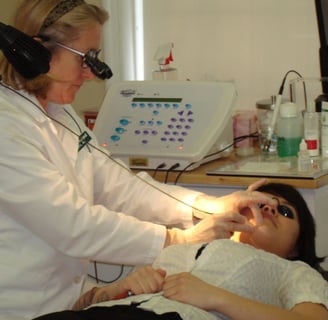


Cleanup of gray, red and blonde hair (after laser also)